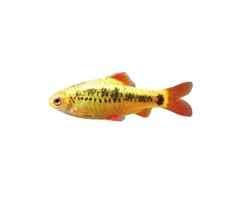The Gold Barb is an attractive and gorgeous aquarium fish. It is very popular among the beginner fish keepers because of its brilliant body coloration and toughness. It is a freshwater ray-finned fish which belongs to the Minnows or carps family (Cyprinidae) of Class Actinopterygii. It is evaluated as least concern (LC) in the IUCN Red List.
Synonyms
This fish (Puntius sachsii) has several synonyms such as Puntius schuberti, Puntius paucimaculatus, Puntius semifasciolatus, Barbus schuberti, Barbus sachsii, Barbus semifasciolatus,Barbus fasciolatus, Puntius hainanensis,Barbus hainani , Barbus fernandez-ypezi ,
Systematic Position
- Phylum: Chordata
- Sub-phylum: Vertebrata
- Class: Actinopterygii
- Order: Cypriniformes
- Family: Cyprinidae
- Sub-family: Barbinae
- Genus: Puntius
- Species: Puntius sachsii
Distribution and Habitat
It is generally found in Vietnum and China especially red river basins. In nature, it prefers to live in stagnant and slowly moving waters such as lakes, paddy fields, ditches where dense aquatic vegetation are available. They prefer to dwell near the substrate within 5 meters depth ranges.
Common Names
It has several common names such as Chinese Barb, Neon Barb, Gold-finned Barb, Schuberti Barb, Sachsi Barb, Golden Barb, Half-banded Barb etc.
Body Shape
Body is elongated and laterally compressed with highly arched backs and forked caudal fin. Mouth is small and bears small barbells on the upper jaw at the corner sides of the mouth.

Body Colors
Body is orange-gold in color with reddish fins. Sides of the body have metallic green or yellow green while a brassy or golden sheen is seen at the ventral side of the body. Body has dark irregular spots while a dark uneven bar is present at the base of the caudal fin.
Body Size and Lifespan
It can grow up to 7 cm in length with a life span that ranges from 5 to 7 years if proper care is taken.
Quick Gold Barb Facts
- Scientific Name:Puntius sachsii
- Origin: South East Asia
- Grown up Size: 8 cm
- Temperament: Peaceful
- Tank Level: Middle to bottom
- Minimum Tank Size: 25 gallons
- Diet: Omnivore
- Breeding: Egg layer
- Water pH: 6.0-8.0
- Hardness: 8-12 dGH
- Temperature: 74-82° F
- Water Movement: Moderate
- Lighting need: Normal-Moderate
- Care level: Easy
- Lifespan: 5 – 7 years with proper care
Food and Feeding Behavior
It is omnivore and in nature, its food consists of plant matters, insects and its larvae, worms etc. In aquarium condition it takes chironomus larvae (blood worm), Tubifex and Artemia (brine shrimp)and frozen foods. To keep your fish happy, feed should be offered 2-3 times daily.
Housing and Care Facts
Gold Barb is a community fish and it requires at least 20 gallon tank but larger is recommended. It should be kept in groups of at least six individuals as a schooling fish. If you keep them in small numbers, it shows shyness behavior. The tank should have lots of space for swimming and hiding places. You can use live aquarium plants such as java moss to create hiding spot. Good water quality should be maintained in the aquarium with a pH of 6.0-8.0, hardness of 8-12 dGH and temperature of 74-82°F. For making your tank environment healthy, you should replace 25-50% tank water every other week.
Tank-mates
The Gold Barb is peaceful and community fish. It is an active fish and it does not show any aggressiveness with their tank-mates. Suitable tank mates include Scissortail Rasboras, Harlequin Rasboras, Rummy Nose Tetras, Black Widow Tetras, Emperor Tetras, Pristella Tetras Glass Bloodfin Tetras, Glowlight Tetras, Head and Tail Light Tetras, Lemon Tetras, Swordtails, Mollies, Zebra Danios, Platies, White Cloud Mountain Minnows, Corydoras catfish and Cherry Barbs etc. It should not be kept with Guppies and bettas.
Breeding Behavior
The Gold barb is an egg-layer and in aquarium condition, you can breed them easily with appropriate care. They lay eggs on the leaves of aquatic plant. In this case, you may use java moss as a breeding ground. They spawn at the first light in the morning and the mature female lays over 400 eggs per spawning. After laying eggs, the parent should be removed from the tank because they prefer to eat their eggs. Hatching of eggs occur within 2-3 days after laying of eggs. The fry should be fed with newly hatched artemia (brine shrimp), infusoria or rotifers and any liquid fry food.
Male and Female Sex Differences
It is very hard to make differentiation between male and female. Generally, the male has smaller and more stream lined body while the female body is stockier. Along the side of the body, the males have strong black patches with pronounced vertical stripe. During the spawning season, the male becomes golden or orange in color while the female becomes slightly duller in color.
Also Read: Best Substrate for Planted Tank: Choose the Best One
Concluding Remarks
The gold barb is a very attractive and popular among the aquarium fish keepers due to its peaceful behavior and brilliant body coloration. This type of aquarium fish is available in the local and online pet fish stores with sensible cost. It is a diurnal fish and at night they take rest at the bottom surface of the tank. It is recommended for beginning fish-keepers due to its hardiness.
